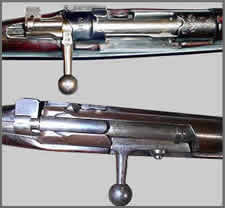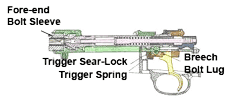- 01: Introduction
- 02: History
- 03: Propellants, Firearms, and Ammunition Development
- 04: Modern Firearms Manufacture
- 05: Small Arms Ammunition
- 06: Evidence Handling Procedures
- 07: Equipment and Instrumentation
- 08: Examination of Firearms
- 09: Cartridge and Shotshell Examination
- 10: Characterization and Evaluation of Fired Projectiles
- 11: Bullet Comparison and Identification
- 12: Gunshot Residue and Distance Determination
- 13: Toolmark Identification
- 14: Communicating Results
- Resources


Mauser Action
Home > Propellants, Firearms, and Ammunition Development > Evolution of Firearms > Breech Loading Firearm Design > Mauser Action

Mauser rifle
Click for larger imageEarly Mausers also started with the split bridge, but with a better safety mechanism than contemporary Mannlichers. By 1889, Mauser had adopted a solid bridge placed in front of the bolt handle. The solid bridge provided a support point for stripper clips to facilitate faster loading. The clip is placed in a rest in the bridge, and the shooter strips the cartridge out of the clip into the rifle’s integral box magazine; the empty clip falls away when the bolt is closed. By 1893, Mauser had abandoned the protruding Mannlicher-style magazine in favor of an internal one that staggered the cartridges side to side for a better fit. Milled from steel, the new Mauser magazine was durable. Stamped sheet metal clips were not required in critical feed operations once the rifle was loaded.

Mauser action
The pinnacle of the military bolt-action rifle was the Mauser Model 1898. The Model 1898 had two forward locking lugs, one large nonbearing safety lug at the rear of the bolt body, and an additional projection behind the bolt handle as an auxiliary safety lug. The bolt body was vented to channel gas from a ruptured cartridge away from the shooter’s face. The feed mechanism controlled the movement of the cartridge from magazine to chamber. A three-position safety mechanism (acting directly on the firing pin) allowed the rifle to be safely loaded and unloaded. The firing pin automatically moved out of engagement with the firing-pin release mechanism.
The Model 1898 Mauser became the basis of the U.S. Model 1903 Springfield rifle. These designs influenced most modern bolt-action sporting rifles and are among the strongest actions built.




